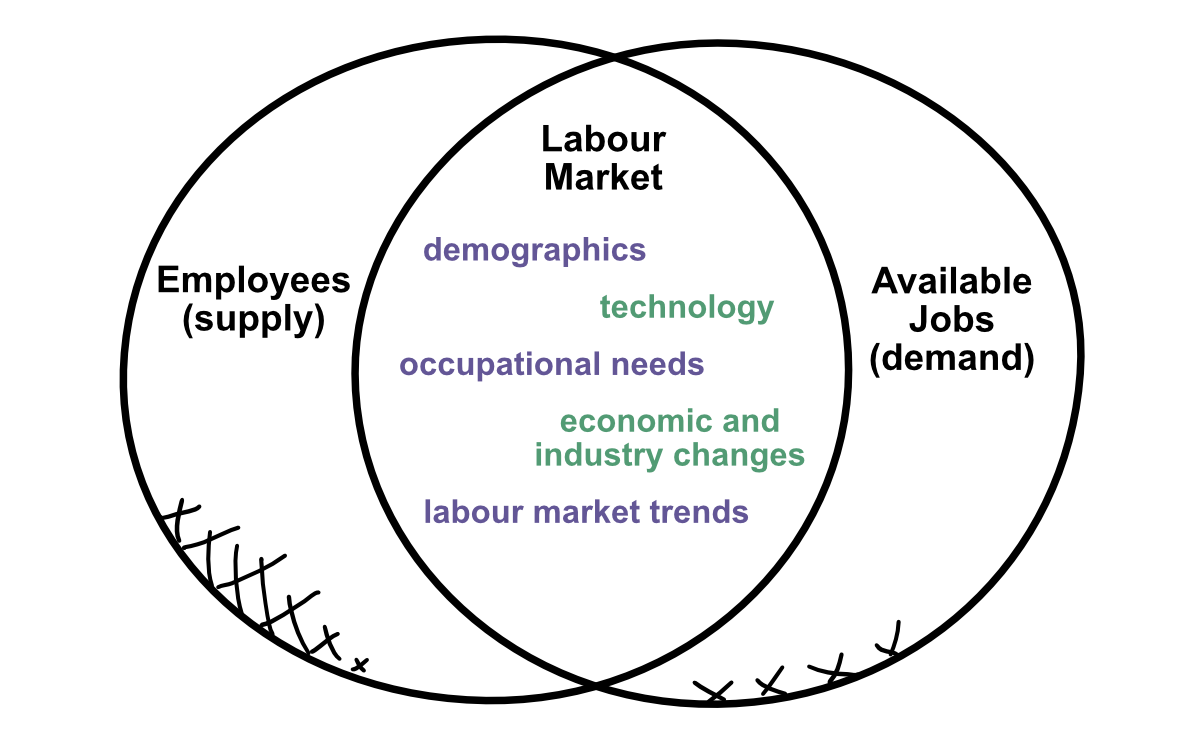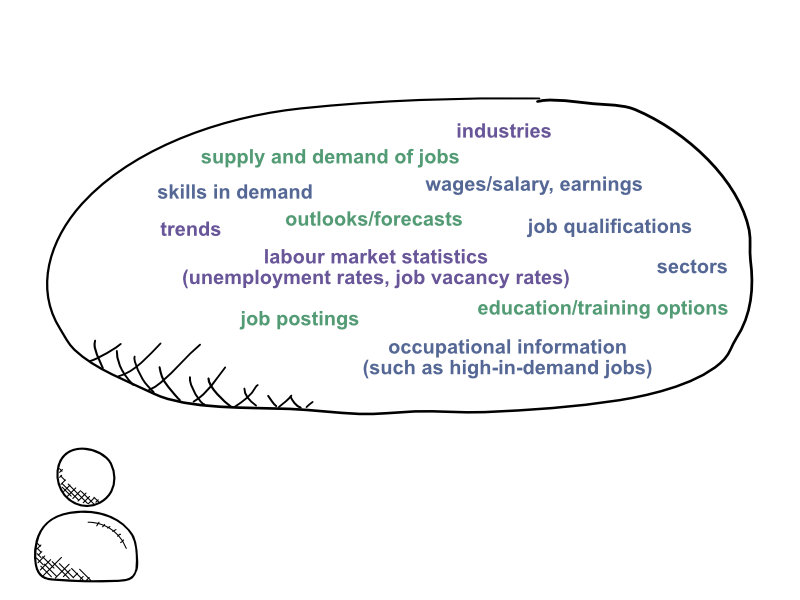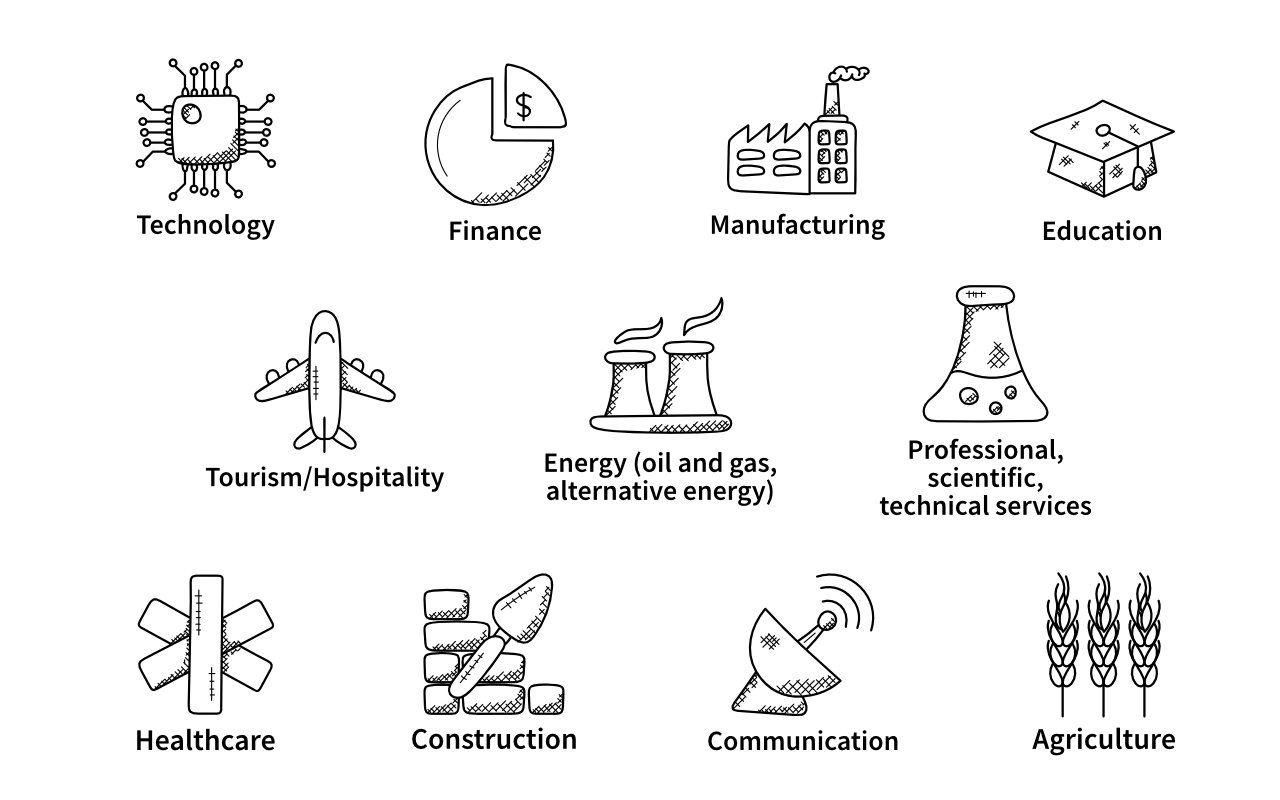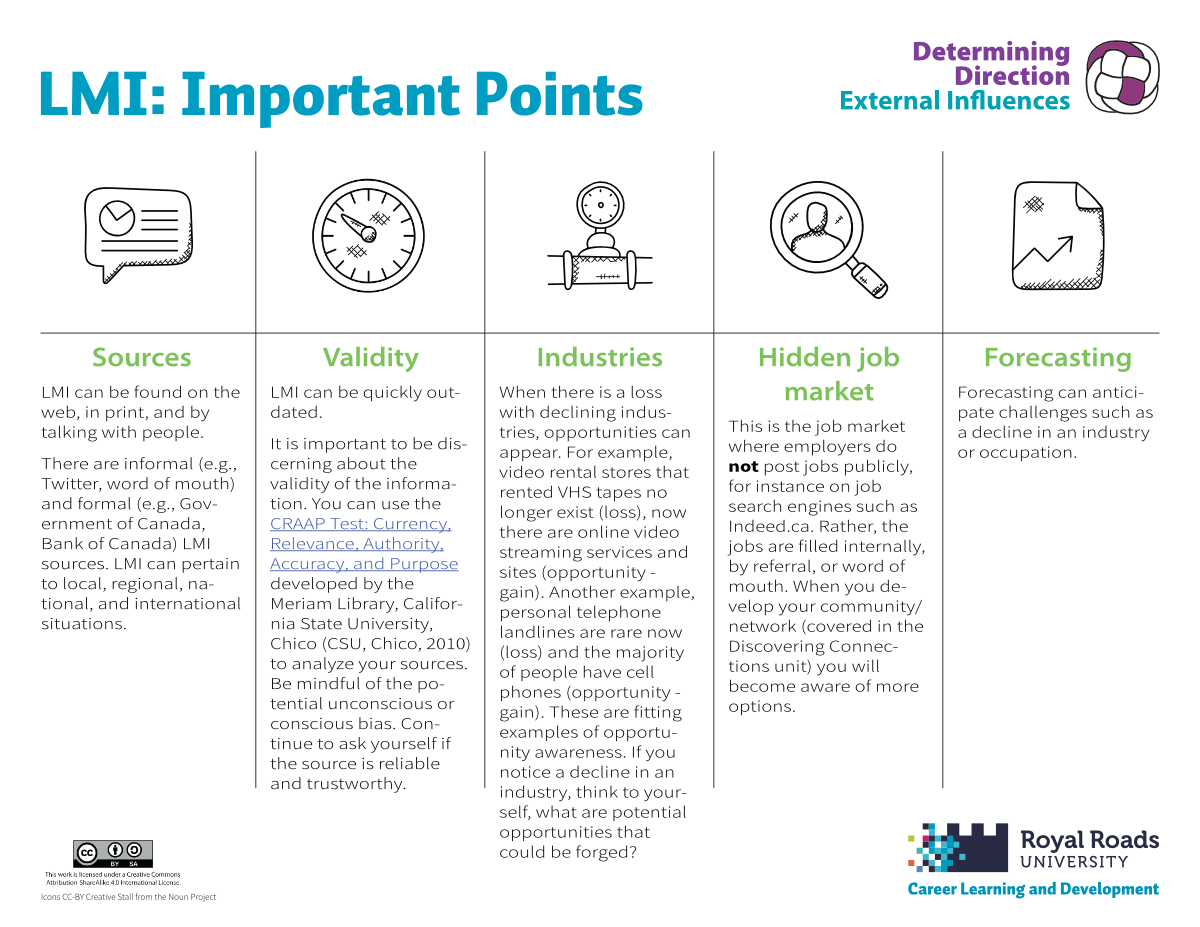Activity: External Influences
| Site: | RRU Open Educational Resources |
| Course: | Career Management Resources for Professionals |
| Book: | Activity: External Influences |
| Printed by: | Guest user |
| Date: | Monday, 2 June 2025, 10:16 PM |
Introduction
This is a multi-page guide to help you identify external influences. You can navigate through the pages using the Table of Contents on the right of your screen (you may need to scroll down to the bottom if you are on a mobile device). You can also advance through the pages using the 'next' and 'previous' buttons at the top and bottom of each page.
![]()
Download the External Influences Worksheet
This worksheet has five components:
- Labour Market Information (LMI).
- Industries.
- Trends.
- Occupational information.
- External factors.
An Important note about LMI
LMI seems dry as dust until it becomes personal, then it becomes relevant and interesting!
This worksheet provides an overview of LMI and specific areas, industries, trends, and occupational information including websites as examples in each of these areas. Then, you can personalize a LMI search like you would with an academic Boolean search, however using LMI terms instead.
Examples of LMI searches using boolean expressions:
Search terms: justice + labour market information + BC
These are a couple of results that were generated from this search:
Labour Market Statistics - Province of British Columbia
Labour Market Bulletin - British Columbia: April 2021 - Job Search
Search terms: leadership + future trends 2021
Results from this search:
Leadership
Trends For 2021 And Beyond - Forbes
2021 Global Talent Trends Report - The Future of Work - Mercer
There are any number of LMI terms that you can use (as you will see throughout the worksheet) and then personalize the search by adding
your program, current sector, industry, and/or occupation, or industries and occupations that you are interested in.
Keep in mind, we have added websites to review and learn about LMI. This research works in tandem with connecting with
others is a current and rich source of LMI, which is covered in the Discovering Connections Unit.
1. Labour Market Information (LMI)
Career management involves career planning. An aspect of career planning is gathering information about the labour market. The labour market is the intersection of supply (employees) and demand (employers with jobs that need to be filled). There are factors such as demographics, technology, occupational needs, economic and industry changes, and labour market trends that influence the labour market (ALIS, 2001-2021).

An example of a demographic factor influencing the labour market could resemble a scenario like this,
- as the aging population increases,
- the need for healthcare services increases,
- healthcare products and services increases, and
- the demand for workers in this field increases,
Or
- as the world slowly adopts solar energy,
- the need for fossil fuels decrease,
- demand for oil and gas equipment and services decrease, and
- the demand for workers in this field decreases.
Labour market information (LMI) is:
comprised of knowledge, facts, data and other relevant institutional information which pertains to the supply and demand of labour. In other words, labour market information is any information that could support the decisions Canadians make in the world of work and in terms of learning, education and training (Labour Market Information Council, 2019)
This is a short video clip (0:58) on LMiC's WorkWords website that provides a definition of LMI (Labour Market Information Council, 2020).
“Labour market intelligence [are] interpretations of labour market information, including predictions about future trends” (Hambly, Bomford, 2008, p.164).
LMI: More Information
LMI is all around us and is reliant on our global economy which can include many aspects:

LMI Important Points
LMI Scenarios
LMI can be valuable for career management and life decision-making in a number of ways.
Here are a few scenario examples:
Scenario one:


Keep in mind that people, forecasts, LMI, and careers are dynamic and change.
- Sometimes people will commit to a direction despite a poor future outlook because they are passionate about a specific career path, and land a job right after they complete their degree.
- Sometimes people pursue an occupation that is in high demand, land a job and hate it.
- Some people pursue a high paying occupation, land a job and love it.
To decrease the risk of putting all your eggs in one basket, an option to consider is freelance work, which entails combining a few contracts together to test or try out various environments and expand your skills.
While there are never any guarantees, conducting LMI research is a prudent and valuable action. Your decision-making will be more informed and you will move forward with your eyes open.
LMI Activity

Web Quest
Find information from at least three sources on the web that pertain to your situation (e.g., making a career change, new to the workforce, or wanting to advance your career) - use the CRAAP Test to discern your sources. There are some links below to get you started, or you can find other sites of your choosing.
Then jot your answers to these questions, either in the downloadable External Influences Worksheet, or in your own journal:
- From the information you found, what could inform your next steps?
- How could you use these sites to your advantage for future use?
- Did you discover any surprising information?
Cost of Living in BC Calculator
Labour Force Survey in brief and Earnings and payroll employment in brief (interactive apps)
Explore Labour Market Information
Explore the Canadian Labour Market- Access news, reports and analyses about the Canadian labour market.
Where to find data on student and apprentice labour market outcomes
2. Industries
"An industry is a group of companies that are related based on their primary business activities." - Investopedia
Staying connected to your industry community/network is effective career management.
- You can learn about emerging trends and opportunities.
- You may gain industry knowledge through professional development, conferences, and/or webinars.
- And, you can also consider how to contribute to your industry.
For those who are in the throes of career decision-making and have not yet landed on a particular direction, identifying an industry of interest could spark the onset of a career journey. There are professions in management, human resources, and communications for example, that can work in any industry from hospitality to education to healthcare.
ACTIVITY:

Go back online again, and
investigate an industry of interest (if you are established in an industry, search for another), an emerging industry, and a declining industry. You can choose from the list below or an industry of your choice.
Jot your answers to these questions in your External Influences Worksheet, or in your journal.
- What challenges do these industries face?
- What information did you learn that could influence your career path?
- If you are established in your career and industry, how do you keep a pulse on your industry?
Here are some ideas for industries to investigate, or choose your own:

|
These sites will be very helpful in your investigation:
3. Trends
"A trend is a general direction into which something is changing, developing, or veering toward. The term may also mean a fashion or craze, i.e., a fad. The verb ‘to trend’ means to develop or change in a general direction." - Market Business News
Trends come and go. Some have longevity, some, not so much. Trends occur all around us, in business, fashion, culture, music, and so on. 'Stories' for example, continue to be a trend in social media. Hybrid or electric cars are an incoming trend.
From a career management perspective, how can you keep an eye on the trends in your occupation and industry so that you will be aware if your profession is flourishing or diminishing?
ACTIVITY:
Watch this video to see the Top 20 Trends for 2021.
Top 20 Trends in 2021 Forecast (9:40)
Jot your answers to these questions in the External Influences Worksheet, or in your own journal:
- What trends have directly or indirectly impacted you personally and professionally?
- What trends can you foresee influencing your future?
- How might you take a course of action to stay ahead of the game?
4. Occupational Information
Occupation is defined as "A collection of jobs sufficiently similar in the work performed to be grouped under a common label" - LMiC
Occupational information can be particularly helpful for career decision-making because of the range of information to acquaint you about an occupation you are unfamiliar with.
Occupational profiles are a great starting point and can include:
- wages/salaries,
- duties,
- future outlook,
- industry required credentials, and
- educational and skill requirements.
However, occupations are changing at such a rapid pace—daily, from decline to emergent—that occupational profiles may not exist yet.
The most direct way to obtain current information such as what a typical day looks like or future trends, is talking with someone who works in this occupation through an information meeting.
ACTIVITY:
Review an occupational profile of interest from two different sites.
Jot your answers to these questions in the External Influences Worksheet, or in your own journal:
- What are the similarities between the occupational profiles from each site, and
- what are the differences between the occupational profiles?
WorkBC - Explore Careers
ALIS - Alberta careers, learning, and employment information
Government of Canada: Job Bank
Government of Canada: National Occupation Classification (NOC)
Occupational Information Network (O*NET) United States
Government of Canada - Learn about an occupation: available jobs, wages, career prospects, skills, job requirements and more.
5. External Factors
Activity:
Identify the factors that are priorities in your life. You will find examples of factors in the External Influences Worksheet such as lifestyle, financial earnings, work, and community involvement.
Circle or jot your important external factors in the External Influences Worksheet, or in your own journal. Some suggestions can be found on the worksheet to get you started.
Tip: Click exit book below to go back to the main page, or take this shortcut to move directly to the module summary.

